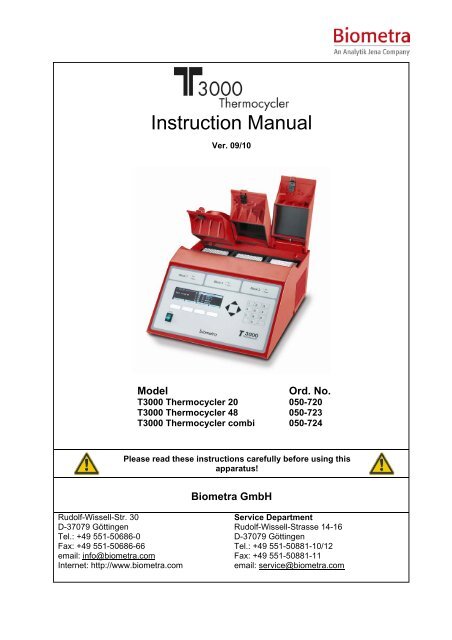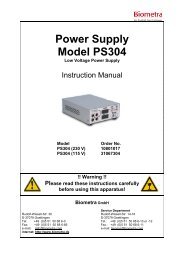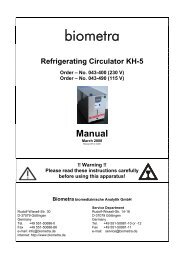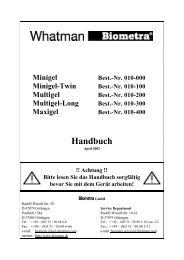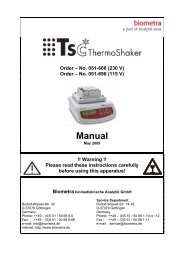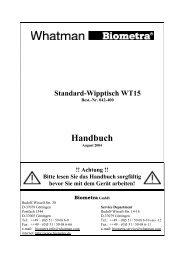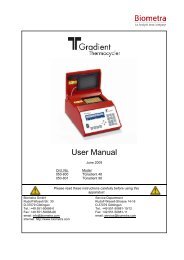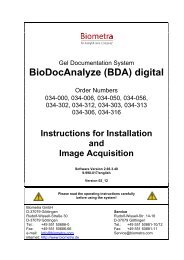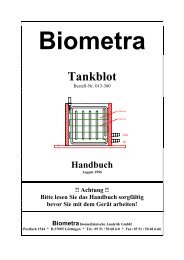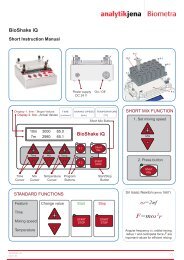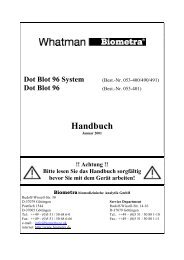Instruction Manual - Biometra
Instruction Manual - Biometra
Instruction Manual - Biometra
You also want an ePaper? Increase the reach of your titles
YUMPU automatically turns print PDFs into web optimized ePapers that Google loves.
<strong>Instruction</strong> <strong>Manual</strong>Ver. 09/10ModelOrd. No.T3000 Thermocycler 20 050-720T3000 Thermocycler 48 050-723T3000 Thermocycler combi 050-724Please read these instructions carefully before using thisapparatus!<strong>Biometra</strong> GmbHRudolf-Wissell-Str. 30D-37079 GöttingenTel.: +49 551-50686-0Fax: +49 551-50686-66email: info@biometra.comInternet: http://www.biometra.comService DepartmentRudolf-Wissell-Strasse 14-16D-37079 GöttingenTel.: +49 551-50881-10/12Fax: +49 551-50881-11email: service@biometra.com
This document describes the state at the time of publishing. It needs not necessarily agree withfuture versions.Subject to change!2 <strong>Instruction</strong> <strong>Manual</strong> T3000 10/2009
14 Warranty............................................................................................................................ 5315 Subject Index .................................................................................................................... 54<strong>Instruction</strong> <strong>Manual</strong> T3000 10/2009 5
1 Introduction1.1 Field of ApplicationsThe <strong>Biometra</strong> T3000 is a Thermocycler that is licensed for PCR applications (research use only)and intended to be used for performing polymerase chain reactions. The development of theinstruments was inspired by the wish to simplify molecular biology research. To reach this goalthe instrument housing, lid and block were totally redesigned, providing so far unrealised speedand temperature uniformity. Innovative user software was developed, driven by <strong>Biometra</strong>s 15years experience in interface design. The result is an easy to use Thermocycler with excellenttechnical specifications.1.2 Special features1.2.1 Three independent Thermocyclers in one instrumentThe T3000 Thermocylcer offers three independent blocks in one housing, thus differentprotocols can be run at the same time. This makes the T3000 Thermocycler the perfectinstrument for laboratories where high flexibility is needed. With a maximum capacity of 3 x 48wells the T3000 also offers high throughput in parallel operation. The T3000 Thermocycler isavailable in three different block versions for 0.2ml tubes, 0.5ml tubes or both in the combiblock.1.2.2 Easy programmingThe T3000 Thermocycler offers intuitive programming and a new memory structure. Newprograms are easily created using the spread sheet layout that shows all important parameterson one screen. Four softkeys directly below the display offer quick access to all functionsneeded in the individual context. For easy retrieval, programs can be stored in individualsubdirectories. Software options include both incremental and decremental temperature andtime, automatic restart after power failure and extended incubation at sub-ambienttemperatures.1.2.3 High speedThe T3000 Thermocycler has been equipped with the latest in Peltier technology. In addition,the heat sink and ventilation system have been completely revised. Thanks to theseimprovements the T3000 achieves faster heating and cooling performance. High ramping ratesprovide both short experimental times and increased specificity.1.2.4 Smart lid technologyLike all <strong>Biometra</strong> Thermocyclers the T3000 provides heated lids with automatic pressurecontrol. The temperature can be set for each lid individually between 30 and 99°C. The uniquedesign ensures the tubes are not damaged in any way by allowing the heated lid to be lowereduntil the optimum pressure is achieved. This enables close contact between lid and tubes, andreliably prevents excessive pressure.6 <strong>Instruction</strong> <strong>Manual</strong> T3000 10/2009
1.3 Technical specifications T3000 ThermocyclerOrder number 050-720 050-723 050-724CapacityT3000 Thermocylcer203 blocks for 20 x 0.5mltubes eachT3000 Thermocylcer483 blocks for 48 x 0.2mltubesor 48 well microplatesor 6 x 8er strips eachT3000 Thermocylcercombi3 combi blocks for 18 x0.5ml tubes **or 48 x 0.2ml tubes,or 48 well microplatesor 6 x 8er stripsHeating rate * 2.1 °C/sec 2.2 °C/sec 1.4 °C/secCooling rate * 1.7 °C/sec 2.0 °C/sec 1.2 °C/secTemperatureUniformity*Temperature rangeControl accuracyBlocksSoftwareProgram memoryDisplayAuto restart after powerfailureCool samples at 4°CHeated lid+/- 0.5 °C-3°C to 99.9°C0.1°CAluminiumProgram steps are easily entered in a spread sheetOptions: time increment, temperature increment, set ramping rate, directmode (for use as thermoblock), program storage in 10 individualsubdirectories10 individual subdirectories,total capacity of 1.500 program steps (equivalent to 250 averageprograms)High brightness CFL backlight graphical LC Display,viewing area 124 mm x 34 mm, resolution 256 x 64 dotsYesYesHigh Precision Smart Lid for optimum lid pressure and excellenttemperature uniformityLid temperature rangePower consumptionNoise emissionInterfacesDimensions (W x D x H)Weight30.0 – 99.0°C420 WattVery lowSerial RS232 port (data interface)30 cm x 38 cm x 19 cm11.9 kgWorking conditions5 – 35°C, 70% relative humidity* According to <strong>Biometra</strong> standard procedure.** Capacity increases to 35 x 0.5 ml tubes by use of small cap tubes<strong>Instruction</strong> <strong>Manual</strong> T3000 10/2009 7
1.4 Legal Notes1.4.1 PCR License – Legal DisclaimerPurchase of a <strong>Biometra</strong> Thermocycler conveys a limited non-transferable immunity from suit forthe purchaser’s own internal research and development and applied fields other than human invitro diagnostics under one or more of US Patents Nos. 5,038,852, 5,656,493, 5,333,675,5,475,610, and 6,703,236, or corresponding claims in their non-US counterparts, owned byApplera Corporation.No right is conveyed expressly, by implication or by estoppel under any patent claim, reagents,kits, or methods such as 5´ nuclease methods, or under any other apparatus or system claim,including but not limited to US Patent No. 6,814,934 and its non-US counterparts, whichdescribe and claim thermal cyclers capable of real-time detection.Further information on purchasing licenses may be obtained by contacting the Director ofLicensing, Applied Biosystems, 850 Lincoln Centre Drive, Foster City, California 94404, USA.<strong>Biometra</strong> biomedizinische Analytik GmbHRudolf Wissell Str. 3037079 Goettingen, Germany•1.4.2 CopyrightAll rights reserved. It is not allowed to copy and publish the manual or parts of it in any form ascopies, micro film or other methods without a written authorisation from <strong>Biometra</strong>.<strong>Biometra</strong> is pointing out that applied company and brand names are usually protected trademarks.1.4.3 Liability<strong>Biometra</strong> is not liable for damages and injuries caused by use not considering these operatinginstructions in parts or completely.1.4.4 Meaning of the <strong>Instruction</strong>s<strong>Biometra</strong> recommends that you first read these instructions carefully. This operation instructionis part of the product and should be kept over the full life-time of the instrument. It should alsobe forwarded to subsequent owners and users. Make sure that additions and updates areinserted into the operation instructions.8 <strong>Instruction</strong> <strong>Manual</strong> T3000 10/2009
2 Safety and Warning Notices2.1 Definition of SymbolsSymbolDefinitionCaution! Refer to instruction manual!Danger! High voltage!Fragile!Danger! Hot surface!2.2 General Safety <strong>Instruction</strong>sPlease read this manual carefully before starting operation of the T3000 Thermocycler. TheT3000 Thermocycler is intended for sample incubation at varying temperatures.• General safety precautions for laboratory work must be observed when working with theT3000 Thermocycler.• The T3000 does not produce a sound power level that could be hazardous for the user.The thermoblock and the heated lid will reach high temperaturesduring operation. Both thermoblock and heated lid can burn you.Rapid heating of the thermoblock can cause liquids to boilexplosively. Always wear safety goggles during operation. Close thelid before starting a program.Do not heat samples without having the lid locked securely.Be aware that samples are reaching high temperatures. Do not touchor open hot tubes or microplates, because hot liquid may quickly spillout.Do not touch the heated lid.Use only suited plastic ware in the T3000 thermocycler. Tubes andplates must show good fit when placed in the thermoblock. Only usetubes that are suited for high temperatures (tight lids).<strong>Instruction</strong> <strong>Manual</strong> T3000 10/2009 9
The T3000 Thermocycler contains no user serviceable parts. Do notopen the housing instrument. Service and repair may only be carriedout by the <strong>Biometra</strong> Service department or otherwise qualifiedtechnical personal.Do not use the instrument when damages of the housing, block,cable or other parts are visible.Prior to connecting the unit to the power source please ensure thatthe voltage selector at the bottom of the instrument is set to therequired voltage.Make sure that the main supply voltage is in accordance with thelabel above the power connection (see section 4.2)Unplug the power cable before you open the T3000 Thermocycler.Danger of electric shock!Make sure that the appliance connector and the plug of the supplycord are accessible, so you can separate the instrument from themains.Connect the T3000 Thermocycler to a grounded socket.When only few samples are put in the block place additional tubes inthe four corner positions. This is to evenly distribute the lid pressureand prevents single tubes from excessive pressure. Use of few tubesmay result in damage of the tubes by excessive pressure.Appropriate safety regulations must be observed when working withinfectious, pathogenic or radioactive material. Ask the responsiblelocal safety inspector for details.The T3000 Thermocycler must not be used with explosive,flammable or volatile liquids.Do not place fingers between lid and housing when opening orclosing the lid.Before opening of the lid, release lid pressure (see section 4.4)It is not necessary to apply oil into the opening of the block in orderto improve the heat transfer between the block and the sampletubes.If you still decide to use oil, do not use silicon oil. Mineral oil may beused.Ensure that both the rear and bottom ventilation slits not clogged bydust or other material. Danger of overheating!Let equilibrate the T3000 Thermocycler to room temperature beforestarting operation.There must be sufficient distance between the ventilation slots on theside of the Thermocycler and a wall or another instrument (min 10cm). Danger of overheating!10 <strong>Instruction</strong> <strong>Manual</strong> T3000 10/2009
This instrument is designed and certified to meet EN 61010-1 safetystandards. It should not be modified or altered in any way. Alterationof this instrument will void the warranty, void the EN61010-1certification, and create a potential safety hazard.Place the T3000 Thermocycler on a stable, non flammable surface ina dry, safe environment. For details see working conditions in table“Technical specifications” (see chapter 1.3).Do not use alcohol (e.g. methanol, ethanol), organic solvents orabrasives to clean the instrument.For transports always use the original <strong>Biometra</strong> box.<strong>Instruction</strong> <strong>Manual</strong> T3000 10/2009 11
3 Installation3.1 Content of delivery1) Thermocycler with exchangeable block module2) Mains connector3) <strong>Manual</strong>4) Short <strong>Manual</strong>Please keep the original packaging material for return shipment in case of servicing. The T3000shipping box provides a specially developed system for contact-free transport of this electronicdevice.3.2 Unpack and CheckUnpack and carefully examine the instrument. Report any damage to <strong>Biometra</strong>. Do not attemptto operate this device if physical damage is present.Please keep the original packing material for return shipment in case of service issues!! Attention !!Please fill out and send back the warranty registration card. This is important for you toclaim full warranty.3.3 Installation Conditions• Place the T3000 Thermocycler on a stable surface in a dry, safe environment. For detailssee working conditions in table “Technical specifications” (see chapter 1.3).• Let equilibrate the T3000 Thermocycler to room temperature before starting operation (1 to6h).• Make sure that the appliance connector and the plug of the supply cord are accessible, soyou can separate the instrument from the mains.• Make sure that the ventilation slots on the bottom and the sides are not obstructed (seesection 4.2). Make sure that there is no object underneath the thermocycler that may blockthe ventilation slots at the bottom (e.g. a piece of paper etc.)• There must be sufficient distance between the ventilation slots on side of the Thermocyclerand a wall or another instrument (min 10 cm).Ensure that both the side and bottom ventilation slits of theside and bottom of the instrument are unobstructed.Insufficient ventilation can cause overheating of theinstrument.12 <strong>Instruction</strong> <strong>Manual</strong> T3000 10/2009
T3000 ThermocyclerSerial numberBlock typeVers. (c) <strong>Biometra</strong> 2004The T3000 then checks all programs in all subdirectories (so called RAM check).T3000 ThermocyclerSerial numberBlock typeChecking directory 7 program 414 <strong>Instruction</strong> <strong>Manual</strong> T3000 10/2009
4 Operating elements4.1 The T3000 Thermocycler front viewLid release boltWheel for lid pressureadjustmentGraphical displayPower switchVentilation slotsKeypad<strong>Instruction</strong> <strong>Manual</strong> T3000 10/2009 15
4.2 The T3000 Thermocycler rear viewRS232serial port(data interface)Power connectionFuse holder(2 x TT 4A, seetype label)16 <strong>Instruction</strong> <strong>Manual</strong> T3000 10/2009
4.3 The T3000 control panelBlock statusLEDGraphicaldisplayT 3000ThermocyclerPower switchSoftkeyscontext sensitiveNavigation keys<strong>Instruction</strong> <strong>Manual</strong> T3000 10/2009 17
4.4 The high performance smart Lid (HPSL)To achieve optimum pressure on the tubes the T3000 is equipped with a height adjustableheated lid.Close the lid:After the samples have been placed in the block close the lid. Turn the wheel clockwise untilyou hear a clicking noise. In this mode the pressure will not increase further, even when youkeep on turning the wheel.Note: The pressure of the lid has been optimized for a fully loaded block. If only very few tubesare loaded to the block you should place dummy tubes in the four corner positions to avoiddamage of tubes by excessive pressure.Open the heated lid:First: Release pressure by turning the wheel counter clockwise. As soon as there is no moreresistance the pressure has been released.Then: Now you can open the lid with the knob.Important: The lid should not be opened under pressure because this leads to damage of thelocking mechanism.18 <strong>Instruction</strong> <strong>Manual</strong> T3000 10/2009
5 Operating5.1 The T3000 displayThe T3000 display provides information about the instrument and about the status of the activeprogram.ProgStepTempTimeLid23.9C24.0C23.8C23.9C23.9C23.9CInfo System Start/Stop EditSoftkey 1 Softkey 2 Softkey 3 Softkey 4The function of the four soft keys beneath the display is context sensitive. The respectivefunction is shown in the display. The function of each key can differ from screen to screen.5.2 Navigation within the T3000 softwareThe T3000 thermocyclers provides spread sheet programming. This means that all programparameters are entered into a simple central spreadsheet.Four navigation keys provide easy navigation within the software. The back and the forward keyhave additional functions as described below:5.3 Create programThe right cursor key moves the cursor to the next field.This cursor can also be used to complete data entry. By pressing the rightcursor settings will be saved and the cursor moves to the next field.In the file directory, this key moves to cursor forward to the next (lower) level.The left cursor key moves the cursor back to the previous field.In most screens this cursor is equivalent to the ”back” softkey.In the file directory, this key moves the cursor back to the higher level.Prior to writing a new program, a program store has to be chosen. The T3000 Thermocyclerprovides 10 subdirectories of which each can store up to 99 different programs. For easyidentification of the selected storage place, the subdirectories can be named (see section).5.3.1 Select directoryStart with the main screen.<strong>Instruction</strong> <strong>Manual</strong> T3000 10/2009 19
ProgStepTempTimeLid23.9C24.0C23.8C23.9C23.9C23.9CInfo System Start/Stop EditPress [Edit] to enter the edit mode.- 0:- 1:- 2:- 3:- 4:Pressedit programPage ↑↓ Name Back EnterYou are now in the directory structure of the edit mode.Use cursor keys to select a subdirectory.- 0:- 1:- 2:- 3:- 4:edit programPage ↑↓ Name Back EnterPress [Enter] to enter highlighted subdirectory. The program storages are displayed.- 3: -------------- 0: empty 1: emptyEdit program 2: empty 3: empty 4: emptyPage ↑ Page ↓ Copy/Del. Edit5.3.2 Select program storeUse cursor keys to select a program store.20 <strong>Instruction</strong> <strong>Manual</strong> T3000 10/2009
1 2 34 5 67 8 9. 0 -Tip: Use numeric keypad to directly enter program number.For numbers smaller than 10 enter “0” plus number.- 3: -------------- 0: empty 1: emptyEdit program 2: empty 3: empty 4: emptyPage Page Copy/Del. EditUsing the softkeys [Page ] and [Page ] you can scroll through the list in 5 program steps.Press [Edit] to write new program in Program store 03.5.3.3 Enter program nameEach program is specified by a program number and a subdirectory number. To make retrievalof a program easier, you can enter a name for each program existing of letters, numbers andsymbols.- 3: -------------- 3:∧ABCDEFGHIJKLMNOPQRSTUVWXYZ-()#C/,〈〉&+.%!Blank Del. Name OK EnterUse cursor keys to select a letter.Accept letter with [Enter].- 3: -------------- 3: B∧ABCDEFGHIJKLMNOPQRSTUVWXYZ-()#C/,〈〉&+.%!Blank ← Del. Name OK Enter<strong>Instruction</strong> <strong>Manual</strong> T3000 10/2009 21
Use cursor keys to select next letter.Accept letter with [Enter]. Repeat until name is completed.- 3: -------------- 3: BIOMETRA∧ABCDEFGHIJKLMNOPQRSTUVWXYZ-()#C/,〈〉&+.%!Blank ← Del. Name OK EnterOnce the name is completed, confirm name with [name OK].5.3.4 Enter lid temperature- 3: -------------- 3: BIOMETRALid temp ----CPreheating OnInfo Page ↓ Save Pgm EnterYou can now enter a temperature for the heated lid.Note: Thanks to a new lid design, significantly lower lid temperatures than in the past can beused for thermocycling. The lower lid temperature leads to a higher temperature uniformitywithin the lid and thus to a more even temperature distribution in the tubes.For instruments featuring the new lid design, a maximum temperature of 99.0°C should beused.- 3: -------------- 3: BIOMETRALid temp 99.0CPreheating OnInfo Page ↓ Save Pgm Enter5.3.5 Select / deselect lid pre-heatingYou can choose whether the lid is pre-heated before the program starts. This is to avoidevaporation during the initial heating phase.Note: During the preheating of the lid, the block is held constant at 25°C.22 <strong>Instruction</strong> <strong>Manual</strong> T3000 10/2009
- 3: -------------- 3: BIOMETRALid temp 99.0CPreheating OnInfo Page ↓ Save Pgm 1. EnterNote: The default setting, which is recommended for most applications, is preheating: On.After all pre-settings have been made, press [Enter] to open the programming spreadsheet.5.3.6 Enter temperature and time settingsThe programming spreadsheet:Temp[C] Time ← # Options -->1:2:3:4:Info Insert/Del Save Pgm EnterNote: In this spreadsheet you can enter all parameters for your cycling protocol. In addition, youcan set special parameters like touch down, ramping rates or time increments. For details onthese special parameters, see section 5.4.1.You can navigate in the spreadsheet without limitations with the fourcursor keysNote: Each setting is confirmed with [Enter]. The cursor moves automatically to the next field.Alternatively, you can confirm a value by moving forward with the cursor keys.Note: At any time you can call up the help function with [Info]Note: In an existing protocol program steps can be deleted and inserted. For further informationon deleting and inserting program steps see section 5.4.1.Now enter temperature for the first step an press [Enter]. In the next row you can enter the timefor this temperature:Temp[C] Time ← # Options -->1: 62.02:3:4:Info Insert/Del Save Pgm Enter<strong>Instruction</strong> <strong>Manual</strong> T3000 10/2009 23
Note: There is a convention on how time settings are entered in all BIOMETRA cyclers:hours • minutes • secondsIf you enter a number without “dot” this value will be interpreted as seconds (“300” => 5minutes). To program minutes enter a “•” after the number of minutes. To enter hours enter •• after the number. You can also enter any combination of hours, minutes and seconds.Example: for 1 hour, 30 minutes, 20 seconds enter 1• 30 • 20.The time values will be displayed in the following format: 0h 00 m 00sEnter “5” “dot” for 5 minutes initial denaturation. Press [Enter]Temp[C] Time ← # Options -->1: 62.0 0h 5m 0s2:3:4:Info Insert/Del Save Pgm EnterRepeat for all temperature steps in the program.5.3.7 Set loopNote: In general, loops are defined by selecting the target for the back loop and the number ofbackloops.Temp[C] Time ← # Options -->1: 62.0 0h 5m 0s2: 62.0 0h 1m 0s3: 80.0 0h 1m 0s4: 35.0 0h 1m 0sInfo Insert/Del Save Pgm EnterIn the row labelled with enter the target step for a backloop and press [Enter].Temp[C] Time ← # Options -->1: 62.0 0h 5m 0s2: 62.0 0h 1m 0s3: 80.0 0h 1m 0s 24: 34.0 0h 1m 0sInfo Insert/Del Save Pgm EnterIn the row labelled with # you can enter the number of backloops. Note: total cycler number = (nbackloops) + 1, e.g. enter 29 for a total number of 30 cycles.24 <strong>Instruction</strong> <strong>Manual</strong> T3000 10/2009
Temp[C] Time ← # Options -->1: 62.0 0h 5m 0s2: 62.0 0h 1m 0s3: 80.0 0h 1m 0s 2 244: 34.0 0h 1m 0sInfo Insert/Del Save Pgm EnterThis protocol now contains 25 cycles between step 2 (62.0°C for 1minute) and step 3 (80.0 °Cfor 1 minute).5.3.8 Cool below ambient temperatureTemp[C] Time ← # Options -->2: 62.0 0h 1m 0s3: 80.0 0h 1m 0s 2 244: 34.0 0h 1m 0s5: 4.0 PauseInfo Insert/Del Save Pgm EnterTo hold the temperature for an indefinite time enter “0”. After pressing [Enter] “pause” isdisplayed.5.3.9 Save programSave program with [Save Pgm]. The program data are written to the permanent memory.Temp[C] Time ← # Options -->2: 62.0 0h 1m 0s3: 80.0 0h 1m 0s 2 244: 34.0 0h 1m 0s5: 4.0 PauseInfo Insert/Del Save Pgm EnterSave program with [Save Pgm].- 3: -------------- 3: BIOMETRASave changes?Cancel Yes NoConfirm changes with [Yes]. The run time is calculated.<strong>Instruction</strong> <strong>Manual</strong> T3000 10/2009 25
- 3: -------------- 3: BIOMETRANumber of steps: 5Run time: 1h13m46>>> Saving program.
Insert / Delete step: 31: 62.0 0h 5m 0s2: 62.0 0h 1m 0s3: 80.0 0h 1m 0s 2 244: 34.0 0h 1m 0s← Del. Cancel Delete InsertPress [Delete]Insert / Delete step: 31: 62.0 0h 5m 0s2: 62.0 0h 1m 0s3: 80.0 0h 1m 0s 2 244: 34.0 0h 1m 0s>>> Deleting step 3...
Insert / Delete step: 31: 62.0 0h 5m 0s2: 62.0 0h 1m 0s3: 80.0 0h 1m 0s 2 244: 34.0 0h 1m 0s← Del. Cancel Delete InsertPress [Insert]Insert / Delete step: 31: 62.0 0h 5m 0s2: 62.0 0h 1m 0s3: 80.0 0h 1m 0s 2 244: 34.0 0h 1m 0s>>> Inserting new step at step 3...
- 3: -------------- 3: BIOMET2Copy Pgm Delete Pgm BackTo copy this program press [Copy Pgm]- 0:Target- 1:- 2:- 3:- 4:Info Page Back EnterSelect the subdirectory with the cursor keys, or enter number on the keypad:Press [Enter]- 0:Target- 1:- 2:- 3:- 4:Info Page Back Enter- 2: -------------- 0: empty 1: emptyTarget 2: empty 3: empty 4: emptyPage Page Back EditSelect program number for the program copy and confirm with [Enter]:Press [Copy]Copy- 3: ---------- 3: BIOMET2To- 2: ---------- 3: emptyBack Copy<strong>Instruction</strong> <strong>Manual</strong> T3000 10/2009 29
5.4.4 Delete programCopy- 3: ---------- 3: BIOMET2To- 2: ---------- 3: empty>>> Copying program...
- 3: -------------- 3: BIOMET2>>> Deleting program...
Temp[C] Time ← # Options -->1: 62.0 0h 5m 0s2: 62.0 0h 1m 0s3: 80.0 0h 1m 0s 2 24 +4: 34.0 0h 1m 0sInfo Insert/Del Save Pgm EnterNote: In the main screen you will find an information that a special parameter has beenmodified. This is indicated by a + in the row labelled with opt .5.5.1 Program time incrementsTo compensate for loss in enzyme activity each step within a loop can be extended from cycleto cycle. Enter the desired time increment [seconds] in the row labelled with dt[s]. This value willbe added to the time value from cycle to cycle.Main funct. dT[C] dt[s] °C/s1: 3.002: 3.003: 10 3.004: 3.00Info Insert/Del Save Pgm EnterNote: A time increment will have an impact on the total runtime depending on the numbers ofcycles and the size of the increment. A program with many cycles and large time increments willtake a significantly longer time than a standard protocol.5.5.2 Program touch downFor some applications it is useful to start with a higher temperature and to decrease thistemperature from cycle to cycle. This subsequent lowering of a temperature is called touchdown.To decrease the temperature from cycle to cycle enter a negative temperature increment in therow labelled with dT[s].Main funct. dT[C] dt[s] [°/s]1: 3.002: 3.003: - 0.10 3.004: 3.00Info Insert/Del Save Pgm EnterNote: Be sure that the temperature decrease is set in a step that lies within a loop. Otherwisethere will be no iterative temperature decrease.5.5.3 Adjust heating and cooling rampsSince the T3000 is a fast Thermocycler it may be necessary to reduce the heating and coolingramp for some applications. For example this is helpful if protocols from other Thermocyclersshall be used.32 <strong>Instruction</strong> <strong>Manual</strong> T3000 10/2009
The heating or cooling ramp respectively can be set in the row labelled with [°/s].Main funct. dT[C] dt[s] [°/s]1: 3.002: 1.003: 3.004: 3.00Info Insert/Del Save Pgm EnterNote: The default setting [3.00 °/s] indicates maximum ramping.5.6 Run program5.6.1 Select and start programMain display:ProgStepTempTimeLid23.9C24.0C23.8C23.9C23.9C23.9CInfo System Start/Stop EditTo run a program press [Start/Stop]Block 1 Block 2 Block 3Inactive inactive inactiveStart Start StartInfo Direct Back EnterSelect block with cursor keys [] and [].Press [Enter]Block 1 Block 2 Block 3Inactive Inactive inactiveStart Start StartInfo Direct Back Enter<strong>Instruction</strong> <strong>Manual</strong> T3000 10/2009 33
- 0:Start block 2- 1:- 2:- 3:- 4:Page Direct Back EnterSelect directory with cursor keys [] []or enter directory number and press [Enter].- 2: -------------- 0: BIOMET1 1: BIOMET1Edit program 2: BIOMET1 3: BERND2 4: BIOMET1Page Page View StartSelect program with cursor keys or enter program number.Note: To be sure that the correct program is selected, it can be displayed by pressing [View](see section 5.6.2).Press [Start] to run program.5.6.2 View program prior to start- 2: -------------- 0: BIOMET1 1: BIOMET1Edit program 2: BIOMET1 3: BERND2 4: BIOMET1Page Page View StartTo check a program prior to start, it can be displayed by pressing [View]- 2: -------------- 3: BERND2Lid temp 99.0CPreheatingOffPage Back StartScroll through the program with [page ↑] and [page ↓↑]34 <strong>Instruction</strong> <strong>Manual</strong> T3000 10/2009
To run program press [Start].Temp[C] Time ← # Options -->1: 62.0 0h 5m 0s2: 62.0 0h 1m 0s3: 80.0 0h 1m 0s 2 244: 34.0 0h 1m 0spage Back Start5.6.3 Display during operationDuring preheating of the lid the following screen is displayed:Prog3: <strong>Biometra</strong>Step 1Temp 20.3 62.062.0C 20.3Time0h 1m13sLid 20.2 99.0 20.2Info System Start/Stop EditNote: While lid preheating, the block is held constantly at 25.0°C. The program starts as soonas the lid has reached the set temperature. During the preheating phase the display of the lidtemperature alternates between the current lid temperature and “preheating”.5.6.4 View remaining run timeDisplay during operation:Prog3: <strong>Biometra</strong>Step 1Temp 20.3 62.062.0C 20.3Time0h 1m13sLid 20.2 99.0 20.2Info System Start/Stop EditTo view remaining run time press [Info].Info Block 1 Block 2 Block 3Dir 3Prog3: BIOMETRARemain1h13mStatus Inactive Active InactiveBackThe current remaining run time id displayed in line 4 [Remain].5.6.5 Pause / stop programDisplay during operation:<strong>Instruction</strong> <strong>Manual</strong> T3000 10/2009 35
Prog3: <strong>Biometra</strong>Step 1Temp 20.3 62.062.0C 20.3Time0h 1m13sLid 20.2 99.0 20.2Info System Start/Stop EditTo pause or stop one of the three blocks press Start/Stop]Block 1 Block 2 Block 3inactive active inactiveStart Pause/Stop StartInfo Direct Back EnterMove cursor to desired block and press [Enter]Press [Pause] to pause blockPress [Stop] to stop blockBlock 2activePause/StopInfo Pause Back StopProg3: <strong>Biometra</strong>Step 1Temp 20.3 62.062.0C 20.3Time PauseLid 20.2 99.0 20.2Info System Start/Stop EditNote: The program pauses in the current state. The word “Pause” is displayed and alternateswith the elapsed time. You can continue the run with [Start/Stop].5.7 System settingsMain screenProgStepTempTimeLid23.9C24.0C23.8C23.9C23.9C23.9CInfo System Start/Stop EditTo change instrument settings press [System]36 <strong>Instruction</strong> <strong>Manual</strong> T3000 10/2009
1 System-Info2 Signal3 Language/Sprache4 Display contrast5 DiagnosticsPage Back EnterScroll though the list with the cursor keys [] []. Enter selected function with [Enter]5.7.1 System InfoSelect System info, Press [Enter]T3000 ThermocyclerSerial Number 123456Block typeVers. 0.51t3p © <strong>Biometra</strong> 2004Info Cancel EnterThis page shows the serial number of the instrument and software version.5.7.2 Switch beep on/offThere is an option for an audible signal whenever a program enters a pause and when theprogram is finished. If this option is active, the beep can be switched off by pressing any key ofthe keyboard.Select Signal, Press [Enter]With signal?YesNOInfo Cancel Enter5.7.3 Select languageThe display of the T3000 can be switched from English to German.Select Language/Sprache, Press [Enter]<strong>Instruction</strong> <strong>Manual</strong> T3000 10/2009 37
Language/Sprache:German/DeutschEnglish/EnglischInfo Cancel EnterTo confirm your selection press [Enter]5.7.4 Display contrastThe display contrast can be set in 4 levels to achieve optimum visibility under individual lightconditions.Select Display Contrast, press [Enter]Contrast (0-4 or arrows): 2Info Cancel EnterUser cursor keys to in/decrease contrast value or directly enter setting.The default setting is “2” which meets average conditions.5.7.5 DiagnosticsThe diagnostic screen contains internal information used by the <strong>Biometra</strong> service departmentfor servicing.5.7.6 Temperature readoutEach T3000 block can be equipped with an in tube-temperature sensor (050-408 for 0.2mlwells; 050-409 for 0.5ml wells). This sensor is to monitor the temperature inside a test tube.The temperature of the in tube-sensor can be shown in the T3000 display. The sensor displaywill replace the display of the lid temperature.Temperature read out:Heated lidTube -SensorCancelEnterNote: The in tube sensor is NOT used to control the instrument.38 <strong>Instruction</strong> <strong>Manual</strong> T3000 10/2009
6 Short manualSafety WarningsDo not open the instrument unless you are authorised to do so. Check thelabel at the backside if the instrument has correct voltage configuration (100V, 115 V or 230 V).Thermocycler main menuThe thermoblock and the heated lid are reaching high temperatures duringoperation. Both thermoblock and heated lid can burn you.Rapid heating of the thermoblock can cause liquids to boil explosively.Always wear safety goggles during operation. Close the lid before starting aprogram.It is not necessary to apply oil into the opening of the block in order toimprove the heat transfer between the block and the sample tubes.If you still decide to use oil, do not use silicon oil. Mineral oil may be used.Ensure that both the rear and bottom ventilation slits at the rear and bottomof the instrument are unobstructed. Insufficient ventilation can causeoverheating of the instrument. Tip: At regularly intervals clean the bottom'sventilation slits from dust to ensure maximum venting capability.ProgStepTempTimeLid23.9C24.0C23.8C23.9C23.9C23.9CInfo System Start/Stop EditSoftkey 1 Softkey 2 Softkey 3 Softkey 4The function of the four soft keys beneath the display is context sensitive. The respectivefunction is shown in the display. The function of each key can differ from screen to screen.Create programPress [Edit] to enter the edit mode.Select a subdirectory with the cursor keys . Press [Enter]Select a program with cursor keys or by number Press [Edit]<strong>Instruction</strong> <strong>Manual</strong> T3000 10/2009 39
Enter program name- 3: -------------- 3:∧ABCDEFGHIJKLMNOPQRSTUVWXYZ-()#C/,〈〉&+.%!Blank Del. Name OK EnterSelect letter with cursor keys and accept with [Enter]Accept name with [Name OK]Enter lid temperature- 3: -------------- 3: BIOMETRALid temp 99.0CPreheating OnInfo Page ↓ Save Pgm EnterSet lid temperature for the <strong>Biometra</strong> High Precision Lid. For most applications, a lidtemperature of 99.0°C is recommended. Confirm with [Enter].Accept preheating mode “on” block starts after the lid has reached the programmedtemperature. Note: Prior to block start, there is a 40 sec temperature equilibrationPress [Enter]The programming spreadsheetTemp[C] Time ← # Options -->1: 99.0 0h 0m30sec2: 50.03:4:Info Insert/Del Save Pgm EnterUse cursor keys to navigate in the spreadsheet:Enter temperature and time for each step and confirm with [Enter].Hours, minutes and seconds are separated by dot (.). To enter for example 1 minute 30seconds type “1” dot “30”. To enter 1 hour type “1” followed by two dots.To program a PAUSE enter zero: “pause” will be displayed after moving forward to thenext step.Set Loop: Enter the target step for a backloop in column “”. The number of backloops(total cycle number –1) is entered in column “#”.Save program with [save pgm]40 <strong>Instruction</strong> <strong>Manual</strong> T3000 10/2009
Start program Press [start/stop] the main screen Select block with cursor keys, press [Enter] Select directory and program with cursor keys or enter program number. Start selected program with [start].Note: After the High Precision Lid has reached the programmed temperature, there is a 40second equilibration phase before the program starts (preheating mode “on”).Display during operationProg 3: <strong>Biometra</strong>Step 1Temp 20.3 62.062.0C 20.3Time0h 1m13sLid 20.2 99.0 20.2Info System Start/Stop EditNote: While lid preheating, the block is held constantly at 25.0°C. During the preheating phasethe display of the lid temperature alternates between the current lid temperature and“preheating”.View remaining run timePress [info] for remaining run timeStop / pause programTo stop / pause active program press [start/stop]Select block with cursor keys.Press [pause] to pause the block or [stop] to stop the block.Confirm with [Enter].Programming optionsTo set special parameters you can scroll the display to the right. Move the cursor to the very right row of the display, labeled with “opt ”.Main funct. dT[C] dt[s] °C/s1: 3.002: 3.003: 3.004: 3.00Info Insert/Del Save Pgm Enter<strong>Instruction</strong> <strong>Manual</strong> T3000 10/2009 41
dt[s]: Time increments. To compensate for loss in enzyme activity each step within aloop can be extended from cycle to cycle. Enter the desired time increment [seconds] inthe row labeled with dt[s]. This value will be added to the time value from cycle to cycle.dT[C]: Touch down. For some applications it is useful to start with a higher temperatureand to decrease the temperature from cycle to cycle. To decrease the temperature fromcycle to cycle enter a negative temperature increment in the row labeled with dT[s].[°C/s] Adjust heating and cooling ramps. Since the T3000 is a very fast thermocycler,it may be necessary to reduce the heating and cooling rates. This can be helpful to adaptprotocols from other older. Enter heating / cooling rate [°C/second] in the row labeledwith dT[sec]. (The default value “3.0” indicates maximum rate)To navigate back to programming spread sheet, move the cursor to the very left side ofthe display (“main functions”).System settingsTo set global parameters like display contrast, instrument language and others: Press [System] in the main menu1 System-Info2 Signal3 Language/Sprache4 Display contrast5 DiagnosticsPage Back EnterSelect option from the list and press [Enter]42 <strong>Instruction</strong> <strong>Manual</strong> T3000 10/2009
7 Trouble shooting7.1 Slow heating and coolingThe T3000 is equipped with a strong ventilator for the cooling of the heat sink. The inlet of thisfan is located at the bottom side of the instrument. Be sure that the inlet is not clogged by dustor other material (e.g. a sheet of paper placed under the cycler can be attached to the inlet asthe fan is in operation). Dust can be removed easily from the inlet with a conventional vacuumcleaner.7.2 Restart due to unrecognised power failureHigh voltage fluctuation can lead to an automatic restart of the thermocycler. In this case thecycler restarts at the step where there power failure has occurred. To avoid voltage fluctuation,do not connect the cycler to a socket shared by a strong power consumer like a refrigerator or acentrifuge.7.3 Adaptation of protocols from other cyclersSince the T3000 is a fast instrument it may be necessary to reduce the heating and coolingramps to run protocols from other cyclers. For the setting of the heating and cooling ramps seesection 5.5.3. Alternatively, the time settings may be extended.7.4 Releasing wheel in case of blocked lidNote: When the lid is in the extreme up or down position, it may happen that the wheel isuncoupled. In this situation the clutch mechanism is active in both directions (clicking noise ineither direction).To unlock wheel, press down metal pin with a ball pen and turn wheel carefully. This pinovercomes the automatic clutch mechanism. Thus, care must be taken not to apply excessivepressure.Lid arrested in upper position:carefully turn wheel with pressed pin CLOCKWISE, until you feelnormal resistance (no more clicking noise, clutch is released).Release pin and turn lid down, until the clutch mechanism isactivated (clicking noise, optimum pressure applied).Lid arrested in down position:carefully turn wheel with pressed pin COUNTER CLOCKWISE,until you feel normal resistance (no more clicking noise, clutch isreleased). Release pin and turn wheel counter clockwise untilpressure is completely released. Open lid.<strong>Instruction</strong> <strong>Manual</strong> T3000 10/2009 43
Important: When the clutch mechanism is active (= optimum pressure is applied), Do not usepin to further increase pressure. This MAY lead to damage of tubes and instrument!7.5 Service and repairThe T3000 Thermocyler contains no user serviceable parts. Do not open the housinginstrument. Service and repair may only be carried out by the <strong>Biometra</strong> Service department orotherwise qualified technical personal.44 <strong>Instruction</strong> <strong>Manual</strong> T3000 10/2009
8 Maintenance and repair8.1 Cleaning and MaintenanceThe T3000 was built to operate for a long time without the need for periodical maintenance.Nevertheless, occasionally cleaning of the air inlet may be necessary to maintain the efficiencyof the Thermocycler. Insufficient airflow may lead to reduced heating and cooling rates. Theinlet for the airflow is located at the bottom side of the instrument. Be sure that the inlet is notclogged by dust or other material (e.g. a sheet of paper placed under the cycler can be attachedto the inlet as the fan is in operation). Dust can be removed easily from the inlet with aconventional vacuum cleaner. Additionally, the Thermocycler housing may be cleaned from timeto time with a smooth cotton cloth. Do not use strong detergents or organic solvents forcleaning. Never treat silver block with abrasive agents.Important: Appropriate safety regulations must be observed when working with infectious orpathogenic material.8.2 Servicing and repairThe T3000 Thermocycler contains no user serviceable parts. Do not open the housinginstrument. Service and repair may only be carried out by the <strong>Biometra</strong> Service department orotherwise qualified technical personal.The Service department offers Thermocycler maintenances and temperature verifications.<strong>Biometra</strong> recommends an annual maintenance and a biannual temperature check for allThermocyclers. Please call the following phone number for detailed information: +49 551-50881-10/12.8.3 Firmware updateFor instruction for firmware upgrade, please contact the <strong>Biometra</strong> Service Department or yourlocal distributor/sales representative.8.4 Replacement of Spare PartsOnly original spare parts mentioned in these operating instructions are allowed.<strong>Instruction</strong> <strong>Manual</strong> T3000 10/2009 45
9 Accessories9.1 Plasticware<strong>Biometra</strong> offers a broad range of plasticware for the use in PCR. The following table provides anoverview for the product portfolio:Cat. no. Description QuantitySingle tubes050-310 0.2 ml tubes with caps 1000 pcs.050-320 0.5 ml tubes with caps 1000 pcs.Tube strips050-254 Strips 8 tubes and flat caps 125 pcs.050-255 Strips 8 tubes and domed caps 125 pcs.48 well plates050-225 48 well microplate 50 pcs.96 well plates050-232 96 well skirted 25 pcs.050-213 96 well non-skirted (low profile) 25 pcs.050-253 96 well non-skirted 25 pcs.384 well plates050-231 HSQ 384 well skirted 50 pcs.050-240 384 well microplate 50 pcs.Miscellaneous050-237 Silcone mat 50 pcs.050-256 Adhesive film 100 pcs.050-257 Heat Sealing Film 100 pcs.050-236 Heat Sealing Film Aluminium 10 pcs.050-194 96 well aluminium plate 1 pcs.050-694 384 well aluminium plate 1 pcs.050-251 Nop mat 96 well 20 pcs.050-252 Nop mat 384 well 20 pcs.46 <strong>Instruction</strong> <strong>Manual</strong> T3000 10/2009
10 ServiceShould you have any problems with this unit, please contact our service department or yourlocal <strong>Biometra</strong> dealer:<strong>Biometra</strong> GmbHService DepartmentRudolf-Wissell-Straße 14 - 16D-37079 GöttingenPhone:++49 (0)5 51 50 68 6 - 10 or 12Fax: ++49 (0)5 51 50 68 6 -11e-mail: Service@biometra.comIf you would like to send the unit back to us, please read the following returninstructions in chapter 10.1.10.1 <strong>Instruction</strong>s for return shipmentIn case of an instrument failure that cannot be fixed by the procedures described in section 7please proceed as follows:• Return only defective devices. For technical problems which are not definitively recognisableas device faults please contact the Technical Service Department at <strong>Biometra</strong> (Tel.: +49 551-50881-10/12, Fax: +49 551-50881-11, e-mail: service@biometra.com).• Please contact our service department for providing a return authorization number (RAN).This number has to be applied clearly visible to the outer box. Returns without the RAN willbe not be accepted!• Important: Carefully clean all parts of the instrument of biologically dangerous, chemical orradioactive contaminants. If an instrument is contaminated, <strong>Biometra</strong> will be forced to refuseto accept the device. The sender of the repair order will be held liable for possible lossesresulting from insufficient decontamination of the device.• Please prepare written confirmation that the device is free from biologically dangerous andradioactive contaminants. The declaration of decontamination (see section 11) must beattached to the outside of the packaging.• Use the original packing material. If not available, contact <strong>Biometra</strong> or your local distributor.• Label the outside of the box with “CAUTION! SENSITIVE ELECTRONIC INSTRUMENT!”• Please enclose a note which contains the following:a) Sender’s name and address,b) Name of a contact person for further inquiries with telephone number,c) Description of the fault, which also reveals during which procedures the fault occurred, ifpossible<strong>Instruction</strong> <strong>Manual</strong> T3000 10/2009 47
10.2 Packing of the Thermocycler<strong>Biometra</strong> uses an extra designed packaging system where the instrument is mounted inbetween two tearproof foils. The Thermocycler is put onto the lower inlet and is fixed in betweenthe foils by pressing the upper inlet down.Note: The Thermocycler is only protected from transport damage if the packing instructions arefollowed and the instrument is mounted in between the foils. <strong>Biometra</strong> will not be responsible fortransport damage by improper packing.Gerät zwischen denFolien schwebendeinspannen!Mount instrumentfloating in betweenthe foils!48 <strong>Instruction</strong> <strong>Manual</strong> T3000 10/2009
11 Equipment Decontamination CertificateTo enable us to comply with german law (i.e. §71 StrlSchV, §17 GefStoffV and §19 ChemG)and to avoid exposure to hazardous materials during handling or repair, please complete thisform, prior to the equipment leaving your laboratory.COMPANY / INSTITUTE__________________________________________________ADDRESS______________________________________________________________PHONE NO _________________________ FAX NO_________________________E-MAIL______________________________________________________________EQUIPMENT Model Serial No______________________________________________________________________If on loan / evaluation Start Date: ____________________________________________________________Finish Date __________________Hazardous materials used with this equipment:______________________________________________________________________________________________________________________________________________________________________________________________________________________________Method of cleaning / decontamination:______________________________________________________________________________________________________________________________________________________________________________________________________________________________The equipment has been cleaned and decontaminated:NAME __________________________________ POSITION _______________________(HEAD OF DIV./ DEP./ INSTITUTE / COMPANY)SIGNED ________________________________ DATE ____________________________PLEASE RETURN THIS FORM TO BIOMETRA GMBH OR YOUR LOCAL BIOMETRADISTRIBUTOR TOGETHER WITH THE EQUIPMENT.PLEASE ATTACH THIS CERTIFICATE OUTSIDE THE PACKAGING. INSTRUMENTSWITHOUT THIS CERTIFICATE ATTACHED WILL BE RETURNED TO SENDER.<strong>Instruction</strong> <strong>Manual</strong> T3000 10/2009 49
General Information for Decontamination:Please contact your responsible health & safety officer for details.Use of radioactive substances:Please contact your responsible person for details.Use of genetically change organism or parts of those:Please contact your responsible person for details.50 <strong>Instruction</strong> <strong>Manual</strong> T3000 10/2009
12 Note for the disposal of electric / electronic waste.Notefor disposal of electric / electronic wasteHinweisfür die Entsorgung von ElektroaltgerätenRenseignementdu traitement des déchets des appareilsélectrique / électroniqueThis symbol (the crossed-out wheelie bin) means, that this product should be brought to thereturn and / or separate systems available to end-users according to yours country regulations,when this product has reached the end of its lifetime.For details, please contact your local distributor!This symbol applies only to the countries within the EEA*.EEA = European Economics Area, comprising all EU-members plus Norway, Iceland andLiechtenstein.--------------------------------------------------------------------------------------------------------------------------------------------Dieses Symbol (die durchgestrichene Abfalltonne) bedeutet, dass dieses Produkt von der Firma<strong>Biometra</strong> für eine kostenlose Entsorgung zurückgenommen wird. Dies gilt nur für Geräte, dieinnerhalb Deutschlands gekauft worden sind.Kontaktieren Sie für die Entsorgung bitte die <strong>Biometra</strong> Service-Abteilung!Außerhalb Deutschlands wenden Sie sich bitte an den lokalen Händler.Dieses Symbol gilt nur in Staaten des EWR*.*EWR = Europäischer Wirtschaftsraum, umfasst die EU-Mitgliedsstaaten sowie Norwegen, Islandund Liechtenstein.--------------------------------------------------------------------------------------------------------------------------------------------Cet symbol (conteneur à déchets barré d´une croix) signifie que le produit, en fin de vie, doit êtreretourné à un des systèmes de collecte mis à la disposition des utilisateurs finaux enconséquence des régulations par la loi de votre pays.Pour des information additionel nous Vous demandons de contacter votre distributeur!Cet symbole s´ápplique uniquement aux pays de l´EEE*.EEE = Espace économique européen, qui regroupe les États membres de l´UE et la Norvège,Islande et le Liechtenstein.<strong>Instruction</strong> <strong>Manual</strong> T3000 10/2009 51
13 EU – Konformitätserklärung / EU - Declaration ofConformityGöttingen, den 20. 08. 2004im Sinne der EG-Richtlinie über elektrische Betriebsmittel zur Verwendung innerhalbbestimmter Spannungsgrenzen 73/23/EWGfollowing the EC directive about electrical equipment for use within certain limits of voltage73/23/EECund / andim Sinne der EG-Richtlinie für die elektromagnetische Verträglichkeit 89/336/EWG.following the EC directive about the electromagnetic compatibility 89/336/EEC .Hiermit erklären wir, daß folgende Thermocycler:Herewith we declare that the following Thermocyclers:Typen / types: T3000 Thermocycler 20, T3000 Thermocycler 48,T3000 Thermocycler combiBest.-Nr. / Order No.: 050-720, 050-723, 050-724den grundlegenden Anforderungen dercorresponds to the basic requirements ofEG-Niederspannungsrichtlinie 73/23/EWG und derEC low voltage directive 73/23/EEC and theEG-Richtlinie über die elektromagnetische Verträglichkeit 89/336/EWG entsprechen.EC directive about the electromagnetic compatibility 89/336/EEC .Folgende harmonisierte Normen wurden angewandt:The following harmonized standards have been used:EN 55011:1998 + A1:1999 + A2:2000 EN 55022:1998 + A1:2000 + A2:2003EN 61000-3-2:2000 EN 61000-3-3:1995 + A1:2001EN 61000-6-1:2001EN 61010-1: 2001 EN 61010-2-010: 1994 + A1: 1996Dr. Jürgen OtteQuality ManagerFormular 006, Ver. 0352 <strong>Instruction</strong> <strong>Manual</strong> T3000 10/2009
14 WarrantyThis <strong>Biometra</strong> instrument has been carefully build, inspected and quality controlled beforedispatch. Hereby <strong>Biometra</strong> warrants that this instrument conforms to the specifications given inthis manual. This warranty covers defects in materials or workmanship as described under thefollowing conditions:This warranty is valid for 24 months from date of shipment to the customer from <strong>Biometra</strong>. Thiswarranty will not be extended to a third party without a written agreement of <strong>Biometra</strong>.This warranty covers only the instrument and all original accessories delivered with theinstrument. This warranty is valid only if the instrument is operated as described in the manual.<strong>Biometra</strong> will repair or replace each part which is returned and found to be defective. Thiswarranty does not apply to wear from normal use, failure to follow operating instructions,negligence or to parts altered or abused.<strong>Instruction</strong> <strong>Manual</strong> T3000 10/2009 53
15 Subject IndexDeclaration of Conformity ........................ 52Decontamination Certificate..................... 49Disposal ................................................... 51Firmware update ...................................... 45Heated lid........................................... 22, 43Maintenance ............................................ 45Operation Voltage .................................... 13Packing .................................................... 48Plasticware............................................... 46ProgramCopy..................................................... 28Create .................................................. 19Delete................................................... 30Delete step........................................... 26Increments ........................................... 32Insert Step ............................................27Loop......................................................24Name ....................................................21Pause....................................................35Run .......................................................33Save......................................................25Stop ......................................................35View......................................................34Remaining run time...................................35Repair .......................................................45Safety precautions......................................9Service and repair ....................................44Servicing...................................................45Technical specifications..............................7Warranty ...................................................5354 <strong>Instruction</strong> <strong>Manual</strong> T3000 10/2009


